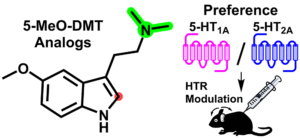 Featured Paper of the Month – September 2025
Featured Paper of the Month – September 2025
Published in ACS Chemica Neuroscience by Grant Glatfelter and Michael Baumann of the NIDA IRP Designer Drug Research Unit.
Summary
A variety of psychedelic compounds are being evaluated for therapeutic potential, but acute psychoactive effects can be problematic. The psychedelic effects of tryptamines, like 5-methoxy-N,N-dimethyltryptamine (5-MeO-DMT), involve activation of 5-HT2A receptors in the brain. Here, we show that 5-MeO-DMT and related analogs potently activate 5-HT1A receptors, which tend to decrease the magnitude of 5-HT2A-mediated behavioral effects in mice. Our findings suggest the balance between 5-HT1A and 5-HT2A agonist effects could be optimized to engender less intense psychedelic experiences, thereby affording safer and more tolerable 5-HT2A medications.
Publication Information
Serotonin 1A Receptors Modulate Serotonin 2A Receptor-Mediated Behavioral Effects of 5-Methoxy-,-dimethyltryptamine Analogs in Mice Journal Article
In: ACS Chem Neurosci, vol. 15, no. 24, pp. 4458–4477, 2024, ISSN: 1948-7193.
